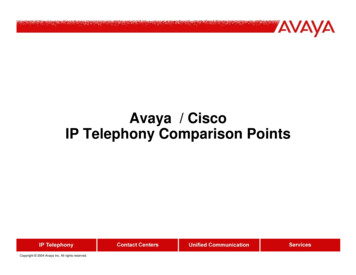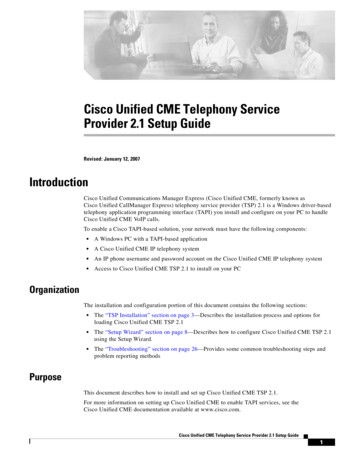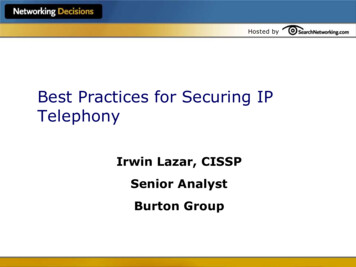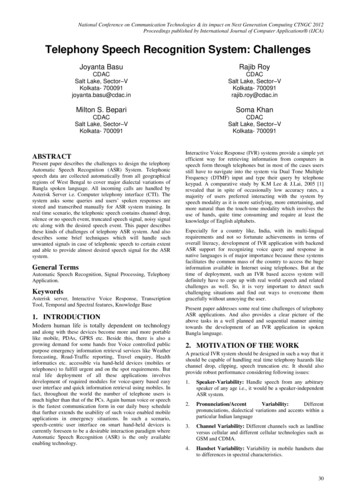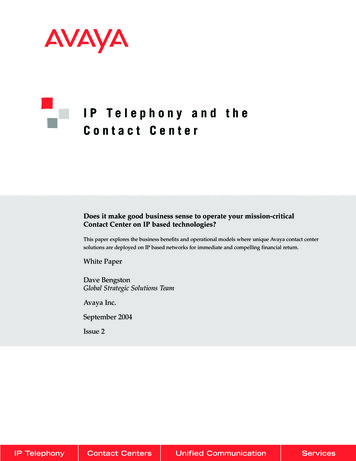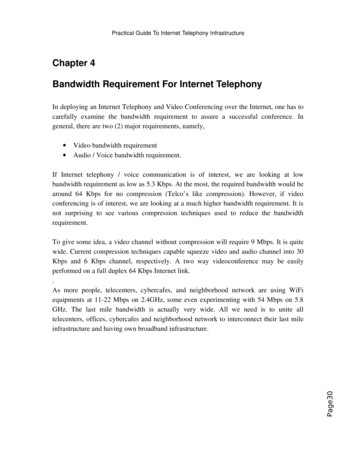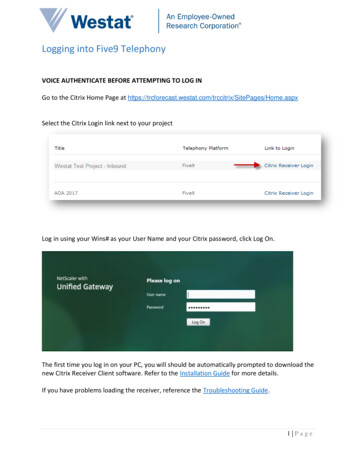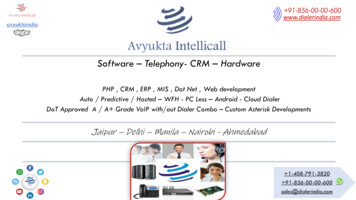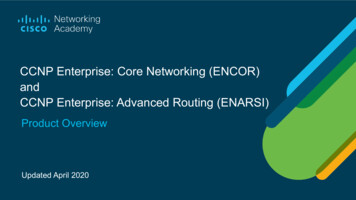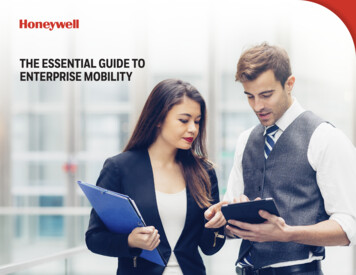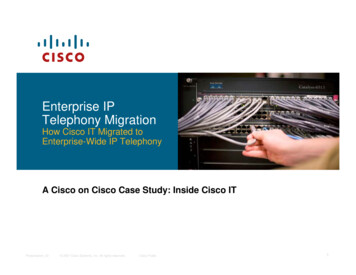
Transcription
Enterprise IPTelephony MigrationHow Cisco IT Migrated toEnterprise-Wide IP TelephonyA Cisco on Cisco Case Study: Inside Cisco ITPresentation ID 2007 Cisco Systems, Inc. All rights reserved.Cisco Public1
Overview ChallengeMigrating 40,000 Cisco employees from a TDM Telephony to IPTelephony Solution – Migration ProcessBefore Deployment – Develop a Solid FoundationPlanning the Migration StrategyMigration ImplementationDay 2 Handoff and SupportMigration: Final StepsPresentation ID 2007 Cisco Systems, Inc. All rights reserved.Cisco Public2
Overview (Contd.) ResultsInternal Cisco cost savings and new capabilitiesBest Practices and Lessons Learned documented in case studyfor clients Next StepsCompleted migration of Telephony, Contact Center andVoicemailTaking advantage of new capabilitiesPresentation ID 2007 Cisco Systems, Inc. All rights reserved.Cisco Public3
Challenge - Migrating 40,000 Ciscoemployees from a TDM Telephony to IPTelephony In 2000 Cisco began replacing its traditional PBXsystems with Cisco Unified CallManager clustersEmployees on campuses worldwide started using Cisco IPphones and Cisco IP SoftPhone software. We realized we needed to:Treat IPT not as a phone replacement, but as a vertical IP dataapplicationUse existing staff to create a cross-functional implementationteamFocus on employee needs and telephony uses, and anticipatedhow IPT would impact them. Planning, communication, teamwork, and understandingyour user’s requirements are as important as technicalexpertisePresentation ID 2007 Cisco Systems, Inc. All rights reserved.Cisco Public4
Solution - Before Deployment – Developa Solid Foundation Create a Cross-Functional TeamMade up of an executive sponsor, a steering committee, aTeam Lead and Program Manager, and a Core Team thatincluded four tracks: technology, support, finance, and eachof Cisco’s global theaters. Ensure Executive Management SponsorshipExecutive sponsorship is critical to gain buy-in from teammembers, financial sponsors, and end users. Cisco’sexecutive sponsor was its CEO, John Chambers, who:championed the initiative, communicated the vision andimportance, and committed the required resources Managing ChangeUnderstanding user needs, communicating the ‘who, what,where, when, and why’ to end users at each phase, tomanage expectations and build user acceptancePresentation ID 2007 Cisco Systems, Inc. All rights reserved.Cisco Public5
Solution - Before Deployment – Developa Solid Foundation (Contd.) Where Do You Begin: The Engineering StoryBuilding the right team requires communication, thencooperation, then integration of voice and data experts. Planning the MigrationUnderstand the InfrastructurePlan the Dial PlanPlan for GrowthPresentation ID 2007 Cisco Systems, Inc. All rights reserved.Cisco Public6
Solution - Planning the Migration Strategy The MigrationDividing the retrofit into logical segments : new employees, adds/moves/changes, then building by building. Assign the Project TeamEvery group who will be impacted: Telephony, LAN and WANEngineering, Implementation, Support, and Finance. Develop the Project PlanSet goals and establish milestones to keep the project moving andshow progress.Keep LAN team two to three weeks ahead of Implementation team.Set up an Operations Center in each building being converted The Communication PlanDetermine who your user groups are, and what they need to know.Use email, a project Website, Email alias, and other mediaPresentation ID 2007 Cisco Systems, Inc. All rights reserved.Cisco Public7
Solution - Planning the MigrationStrategy (Contd.) Identify Critical UsersAdmin personnel, Executives, Call Centers and Help Deskshave special needs User TrainingProvide different user training options (Web-based training,demos, user guides, facilitated sessions) and let users choose Identify Operational ChangesPay attention to new support models, to security issues, and todifferent handling of modem lines and unused linesPresentation ID 2007 Cisco Systems, Inc. All rights reserved.Cisco Public8
Solution - Migration Implementation LAN Infrastructure RequirementsStandardize LAN design globally to maintain consistency, increasenetwork stability, and reduce support costsLAN QoS is important WAN Infrastructure RequirementsProvision / size WAN links to support both data and voicerequirementsWAN QoS is critical Network ProvisioningCable provisioning is simplified with a single network, but cabledistance limitations must be understood in large buildings. Provisioning the VLANCreate separate VLANs for Voice and DataPresentation ID 2007 Cisco Systems, Inc. All rights reserved.Cisco Public9
Solution - Migration Implementation(Contd.) Connecting to VoicemailAnalyze traffic carefully to plan for integration with voicemail The ImplementationPerforming a detailed site survey (collect key information aboutusers, services, and special configurations Customer ServiceHeighten customer service to ease user fearsPresentation ID 2007 Cisco Systems, Inc. All rights reserved.Cisco Public10
Solution - Day 2 Handoff and Support The Support TeamEngage the Operations and Support teams early to ensure familiarityand identify special issues early. The Support ModelUse existing support model as much as possibleCisco’s model includes tiered support, escalating priority designationsand associated response times. The Support ToolsCisco IT uses EMAN (Enterprise Management) for CallManager andother IPT equipment availability and alarms, and for collecting historicadata for problem identification, trending, capacity planning, andstatistical analysis. Other monitoring tools include PerformanceMonitor, Event Viewer, CallManager Trace, and Sniffer Trace.Determine service thresholds for availability and performance; Ciscouses an automatic paging system for all alerts.Presentation ID 2007 Cisco Systems, Inc. All rights reserved.Cisco Public11
Solution - Day 2 Handoff and Support(Contd.) Power BackupAll Cisco Catalyst 6500 Series Switches and Cisco Unified CallManager servers that support IP telephony at Cisco are on UPSpower. ServiceabilityAvailability goals are based on business requirements. CiscoUnified CallManager availability standards are currently set for99.99% LAN; SRST routers protect voice processing at remotesites. Backup Support and RecoveryMost IPT network devices, including Cisco IOS gateway andMGCP gateway devices, support TFTP for configuration filebackups.Presentation ID 2007 Cisco Systems, Inc. All rights reserved.Cisco Public12
Solution - Migration: Final Steps (1) Change ManagementGood change management procedures can minimize downtime. Change requests are reviewed for impact to the network, fit,timing, and upgrades already in the funnel. Software UpgradesCisco created a Call Manager software upgrade checklistNeed to keep upgrades synchronized with all the versions thatwere currently active. Disaster RecoveryIP Telephony made Disaster Recovery easier, and should befactored into current DR plans.Presentation ID 2007 Cisco Systems, Inc. All rights reserved.Cisco Public13
Solution - Migration: Final Steps (1)(Contd.) PBX Lease ReturnsThe Cisco IT IP Telephony implementation schedule waslargely dictated by the PBX lease return dates. The initiativeinvolved returning 55 PBXs Vendor Rules of EngagementDiscontinuing lease arrangements, returning equipment, andmigrating to new technology will change the vendorrelationship.Honesty, trust, integrity, and continuing to treat them as partnerand valued member of the team will enable the process to gomore smoothly.Presentation ID 2007 Cisco Systems, Inc. All rights reserved.Cisco Public14
Solution - Migration: Final Steps (2) Non-leased Equipment DisposalEquipment was sold, transferred internally, or discarded and writtenoff. Retrofit Clean up Decide whether to disconnect remaining modem andanalog lines or to steer them onto the CallManager. Preparing Your Network for the Future Put in place a system to analyze new IPT technology as itbecomes available, test for feasibility, provide an adoptionposition, and ensures that all teams are involved and inagreement (IT Project Life Cycle) Lessons Learned Document lessons learned for future deployments withinthe business environmentPresentation ID 2007 Cisco Systems, Inc. All rights reserved.Cisco Public15
Results - Benefits to Cisco and toCustomers Benefits to CiscoReduced costs – PBX leases, cabling costs, operations costs,voice traffic costsNew technology leads to increased flexibility – New features,Extension Mobility, Cisco IP Communicator, Cisco Unified VideoTelephony Advantage, Cisco MeetingPlace integration, other IPtelephony applications Benefits to CustomersBy documenting the processes, the planning considerations andeven the checklists used within Cisco IT, Cisco has preservedmany of the lessons learned from its migration from TDM to an IPTelephony environment.Customers can reduce their migration time and effort by learningfrom Cisco IT’s initial trial and error in 2000-2001.Presentation ID 2007 Cisco Systems, Inc. All rights reserved.Cisco Public16
Next Steps - Summary Migration of all TDM to IP Telephony – Complete(2002) Migration of all Contact Centers from TDM to IPContact Center architecture - Complete (2002) Migration of all TDM Voicemail to Unity Voicemail –Complete (2003) Full deployment of IP Communicator and VTA – underway (May 2006) Upgrading to Linux-based CallManager 5.x – underway (May 2006) Continuing to develop and test more IP Telephonyapplications - ongoingPresentation ID 2007 Cisco Systems, Inc. All rights reserved.Cisco Public17
To read the entire case study, or for additional Cisco IT case studies on avariety of business solutions, visit Cisco on Cisco: Inside Cisco ITwww.cisco.com/go/ciscoitPresentation ID 2007 Cisco Systems, Inc. All rights reserved.Cisco Public18
The Migration Dividing the retrofit into logical segments : new employees, adds/ moves/changes, then building by building. Assign the Project Team Every group who will be impacted: Telephony, LAN and WAN Engineering, Implementation, Support, and Finance. Develop the Project Plan Set goals and establish milestones to keep the project moving and
